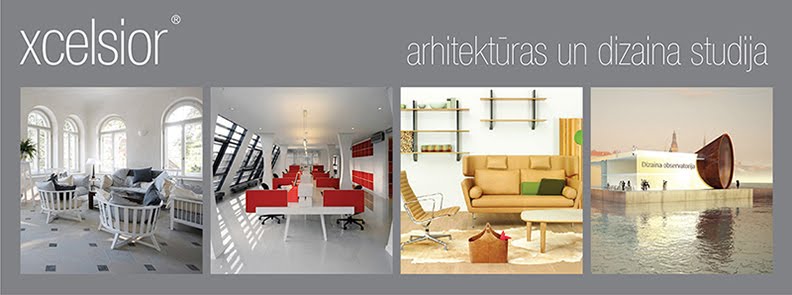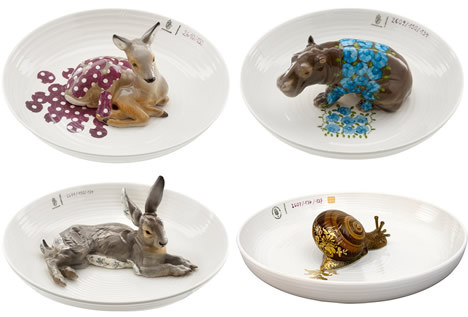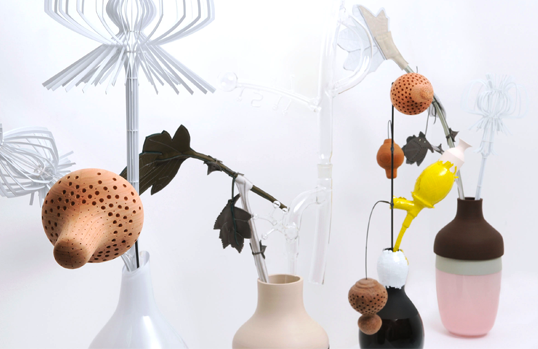Iepazīstieties: HELLA JONGERIUS
„Es mēģinu radīt produktus, kurus var mīlēt un kurus cilvēki vēlas
paturēt savā īpašumā visu dzīvi un nodot nākamajām paaudzēm”.
“Viss perfektais ir mačo un garlaicīgs. Man patīk redzēt
gatavotāja pieskārienu.”
Holandiešu dizainere Hella Jongerius
dzimusi 1963. gadā De Meern pilsētā, netālu no Ūtrehtas un 1988. gadā iestājās
Eindhoven Dizaina akadēmijā, lai studētu industriālo dizainu. 1993. gadā,
beidzot akadēmiju, jaunā dizainere kopā ar Droog
Design piedalījās Milānas Mēbeļu izstādē ar vannas istabas paklājiņu. 2000.
gadā viņa Roterdamā izveidoja savu dizaina kompāniju Jongeriuslab, caur kuru tiek ražoti pašas dizaineres projekti, kā
arī attīstīti projekti tādiem klientiem kā Maharam (Ņujorkā), Royal Tichelaar
Makkum (Nīderlande), Vitra (Šveice) un Ikea (Zviedrija).
Hella Jongerius ir kļuvusi
slavena ar savu spēju sapludināt industriālo ar amatniecisko, tradicionālo ar
laikmetīgo , kā arī mākslu ar tehnoloģijām. Viņas darbi ir bijuši redzami tādos
muzejos un galerijās kā Cooper Hewitt Nacionālajā Dizaina muzejā (Ņujorkā),
MoMA (Ņujorkā), Dizaina muzejā (Londonā), Galerie KREO (Parīzē), kā arī Moss
galerijā (Ņujorkā).
Dizainere ir arī sadarbojusies ar
Porzellan Manufaktur Nymphenburg,
veidojot Nymphenburg Sketches
servīzi, kā arī lielāko daļu no Four
Seasons kolekcijas. Visslavenākās no šīs sadarbības ir viņas Animal Bowls. Izvēloties 5 no 700
dzīvnieciņu figūriņām Nymphenburg
arhīvā, viņa tās ievietoja bļodiņās, pievienojot rakstus un ornamentus.
Hella Jongerius pie saviem
dizaina elkiem pieskaita Achille Castiglioni, kā arī mūsdienu dizaineri Jasper
Morrison, kurš esot šīs profesijas karalis. Iedvesmojoties no skaistiem
rītiem,
vēstures un tradīcijām, kā arī no sava drauga Jurgen Bey, dizainere rada produktus, kurus cilvēki izmantos paaudžu paaudzēs un par savu otrreizējās pārstrādes veidu dēvē senu formu un tradīciju izmantošanu. Iesakot jaunajiem dizaineriem veidot savus individuālos stāstus un izmantot savas personības ideju ģenerēšanā, Hella Jongerius atzīst, ka reizēm nožēlo to, ka dizains nav politiski vai sociāli aktīva sfēra.
vēstures un tradīcijām, kā arī no sava drauga Jurgen Bey, dizainere rada produktus, kurus cilvēki izmantos paaudžu paaudzēs un par savu otrreizējās pārstrādes veidu dēvē senu formu un tradīciju izmantošanu. Iesakot jaunajiem dizaineriem veidot savus individuālos stāstus un izmantot savas personības ideju ģenerēšanā, Hella Jongerius atzīst, ka reizēm nožēlo to, ka dizains nav politiski vai sociāli aktīva sfēra.
Pārceļot savu darbnīcu uz
Berlīnes rajonu Prenzlauer Berg, Hella Jongerius meklējusi jaunu sākumu, kā arī
vēlējusies aizbēgt no visiem un palikt divatā ar savu darbu. Viņas krāsainais
dizains bieži šķiet nepabeigts un nedaudz ievainots – šādā veidā dizainere
piešķir rokdarba vērtību rūpnieciski ražotiem priekšmetiem. Piemēram, viņas B-Set porcelāna galda piederumi speciāli
tika apdedzināti pārāk augstā temperatūrā, piedodot katram priekšmetam unikālu
deformāciju.
2005. gadā projektētā Polder sofa kompānijai Vitra sastāv no modulārām daļām dažādās
tekstūrās un nokrāsās, un tai ir piešūtas pogas, kas radītas, iedvesmojoties no
krāmu tirgu atradumiem. Dizainere min, ka mārketinga speciālisti esot teikuši,
ka sešu nokrāsu sofu nebūs iespējams pārdot, un viņa pierādīja pretējo.
Pārdošanas nodaļas bieži pretojoties viņas darbiem tieši tāpēc, ka tie vienmēr
ir novitātes.
Pēdējā laikā dizainere ir uzsākusi misiju, lai pārveidotu dizaina industrijas attieksmi pret krāsām un to izmantošanu. Atzīstot industriālās krāsu paletes nabadzību, Hella Jongerius vēlas ieviest krāsas, kuras gaismā mainās un kļūst dzīvīgākas. Tāpēc arī 2005. gadā Vitra uzticēja dizainerei krāsu konsultantes amatu, un viņas pirmais lēmums bija uzsākt plastmasas Eames krēslu ražošanu trijos dažādos baltos toņos. Palīdzot kurpju kompānijai Camper aizvilināt klientus no ierastajiem melnajiem un brūnajiem toņiem, Hella Jongerius arī ražo pati savas krāsas kopā ar Šveices kompāniju KT.COLOR.
Pēdējā laikā dizainere ir uzsākusi misiju, lai pārveidotu dizaina industrijas attieksmi pret krāsām un to izmantošanu. Atzīstot industriālās krāsu paletes nabadzību, Hella Jongerius vēlas ieviest krāsas, kuras gaismā mainās un kļūst dzīvīgākas. Tāpēc arī 2005. gadā Vitra uzticēja dizainerei krāsu konsultantes amatu, un viņas pirmais lēmums bija uzsākt plastmasas Eames krēslu ražošanu trijos dažādos baltos toņos. Palīdzot kurpju kompānijai Camper aizvilināt klientus no ierastajiem melnajiem un brūnajiem toņiem, Hella Jongerius arī ražo pati savas krāsas kopā ar Šveices kompāniju KT.COLOR.
Jau meklējot jaunu projektu,
radošā un neapstādināmā dizainere ir ķērusies pie plastmasas izpētes, lai
padarītu to pircējiem tīkamāku. Izvairoties no ierastajiem pieņēmumiem, ka
plastmasa izskatās vai nu lēti vai pārāk futūristiski, dizainere vēlas to
pietuvināt videi draudzīgajiem materiāliem, uzsverot bioplastmasas
nepieciešamību. Kārtējā misija dizaina nebēdnei ar apbrīnojami plašu komforta
zonu.
Introducing: HELLA
JONGERIUS
"I'm
trying to make products that can be loved and that people want to own their
whole lives to then pass them on to the family."
“Perfection
is macho. And boring. I like to see the hand of the maker.”
Dutch
designer Hella Jongerius was born in 1963 in De Meern, not far from Utrecht and
started studying industrial design in Eindhoven Design Academy in 1988.
Graduating from the academy in 1988 the young designer participated with her
Bath Mat in the Milan Furniture Fair with Droog
Design. In 2000 she created her own design company Jongeriuslab in Rotterdam through which her own projects are
produced, as well as the projects for such clients as Maharam (New York), Royal
Tichelaar Makkum (Netherlands), Vitra
(Switzerland) and Ikea (Sweden).
Hella
Jongerius has become famous for her ability to blend the industrial with craft,
the traditional with contemporary and art with technology. Her work has been
exhibited in such museums and galleries as Cooper
Hewitt National Design Museum (New York), MoMA (New York), Design
Museum (London), Galerie KREO
(Paris) and Moss Gallery (New York).
The
designer has also collaborated with Porzellan
Manufaktur Nymphenburg, creating the Nymphenburg
Sketches service and the biggest part of the Four Seasons collection.
The most famous part of this collaboration is the Animal Bowls. By
choosing 5 out of the 700 animal figurines in the Nymphenburg archive, she put them in bowls and added patterns and
ornaments.
Hella
Jongerius mentions Achille Castiglioni as her design idol, as well as the
contemporary designer Jasper Morrison whom she calls the king of the
profession. Drawing inspiration from beautiful mornings, history and
traditions, as well as from her friend Jurgen Bey, the designer creates
products that people will use from generation to generation and calls using old
forms and traditions as her way of recycling. By advising young designers to create their own individual stories and
to use their own personalities in ideas, Hella Jongerius admits that at times she
regrets that design isn’t a politically or socially relevant sphere.
By
moving her company to Prenzlauer Berg in Berlin, Hella Jongerius was looking
for a fresh start and wanted to run away from everyone and be alone with her
work. Her colourful design can seem unfinished or damaged at times – in this
way the designer gives hand-crafted value to industrially produced objects. For
example, her B-Set porcelain
tableware was intentionally fired at too high a temperature to add each object
a unique deformation.
The
2005 Polder sofa for Vitra consists of modular parts in
different textures and shades and hand-sewn buttons modeled after thrift shop
finds. Designer mentions that the marketing specialists had said it will be
impossible to sell a sofa in six different shades, and she proved them wrong.
Sales departments usually resist her work especially because of its novelty.
Lately the
designer has begun a mission to change the design industry’s attitude and use
of colour. By admitting how poor the industrial colour palette is, Hella
Jongerius wants to include colours that change in the light and are more
lively. Thus in 2005 Vitra entrusted
her with the position of colour consultant, and her first decision was to begin
producing the Eames plastic chair in
three different shades of white. By helping the shoe company Camper to lure their clients away from
the usual shades of black and brown, Hella Jongerius also produces her own
colours with the Swiss company KT.COLOR.
Already looking
for a new project, the creative and unstoppable designer has started research
on plastics to make it more appealing to the clients. By avoiding the usual
presumptions that plastic looks either cheap or too high-tech futuristic, the
designer wants to make it more eco-friendly, by stressing the necessity of
bio-plastics. Another mission for the rogue designer with an incredibly wide
comfort zone.




Nav komentāru:
Ierakstīt komentāru